In today’s digital age, where information travels at the speed of light, keeping track of your online presence is paramount. Whether you’re a brand, a marketer, or an individual seeking to manage your online reputation, online media monitoring tools have become indispensable. These tools offer a comprehensive solution to monitor and analyze conversations happening across various online platforms, providing valuable insights to shape your strategies and decisions.
What are Online Media Monitoring Tools?

Online media monitoring tools are software applications designed to track, monitor, and analyze content across the vast landscape of the internet. They scour social media platforms, news websites, blogs, forums, and other online channels to gather data relevant to your specified keywords or topics. By aggregating this data, these tools offer valuable insights into brand mentions, industry trends, customer sentiments, and competitive landscapes.
Importance of Monitoring Online Media
In a hyper-connected world where news spreads rapidly and public opinions can make or break a brand, monitoring online media is no longer optional—it’s essential. Whether you’re managing a brand’s reputation, conducting market research, or staying abreast of industry trends, online media monitoring provides real-time insights that empower informed decision-making.
Types of Online Media Monitoring Tools
1. Social Media Monitoring Tools
Social media monitoring tools focus on tracking conversations, mentions, and engagements across various social media platforms such as Facebook, Twitter, Instagram, LinkedIn, and more. These tools help businesses monitor brand mentions, gauge customer sentiments, track competitors, and identify relevant influencers.
2. News Monitoring Tools
News monitoring tools specialize in tracking mentions and articles across online news websites, blogs, and publications. They allow users to stay updated with the latest news relevant to their industry, competitors, or specific topics of interest.
3. Brand Monitoring Tools
Brand monitoring tools offer a comprehensive solution for monitoring brand mentions, sentiment analysis, and reputation management across the web. They enable businesses to track mentions of their brand, products, or services, identify emerging trends, and respond promptly to customer feedback or crises.
Key Features to Look for in Online Media Monitoring Tools
1. Real-time Monitoring
The ability to monitor online conversations in real time is crucial for staying ahead of emerging trends, crises, or opportunities. Look for tools that offer real-time alerts and notifications to keep you informed as events unfold.
2. Sentiment Analysis
Effective sentiment analysis capabilities allow you to gauge the overall sentiment surrounding your brand or specific topics. Advanced sentiment analysis tools can differentiate between positive, negative, and neutral mentions, providing deeper insights into public perceptions.
3. Customizable Dashboards
Customizable dashboards enable users to tailor the interface to their specific needs and preferences. Look for tools that offer flexibility in dashboard customization, allowing you to prioritize metrics, track key performance indicators (KPIs), and visualize data in a way that suits your workflow.
4. Competitive Analysis
The ability to monitor competitors’ activities, mentions, and sentiments can provide valuable insights into market dynamics and competitive landscapes. Look for tools that offer robust competitive analysis features, allowing you to benchmark your performance against industry peers and identify areas for improvement.
Benefits of Using Online Media Monitoring Tools
1. Stay Updated with Trends
By monitoring online conversations and industry trends in real time, you can stay ahead of the curve and adapt your strategies accordingly. Whether it’s identifying emerging topics, monitoring competitor activities, or tracking consumer preferences, online media monitoring tools help you stay informed and agile.
2. Enhance Brand Reputation Management
Proactively managing your brand’s online reputation is essential in today’s digital landscape. Online media monitoring tools enable you to track brand mentions, respond to customer feedback, and address potential crises before they escalate, thereby safeguarding your brand’s reputation.
3. Improve Customer Engagement
By monitoring conversations and engaging with your audience in real-time, you can foster stronger relationships and build brand loyalty. Online media monitoring tools provide valuable insights into customer sentiments, allowing you to tailor your messaging, address concerns, and deliver personalized experiences.
Top Online Media Monitoring Tools in the Market
1. Mention
Mention is a comprehensive online media monitoring tool that allows users to monitor brand mentions, track social media conversations, and analyze sentiment trends. With customizable alerts and intuitive dashboards, Mention helps businesses stay informed and proactive in managing their online presence.
2. AIM Insights
AIM Insights offers powerful social listening and analytics capabilities, allowing businesses to monitor conversations across social media, news sites, blogs, and forums. With advanced sentiment analysis and competitive benchmarking features, AIM Insights provides valuable insights to inform strategic decision-making.
3. Hootsuite
Hootsuite is a popular social media management platform that offers robust monitoring and engagement tools. With features such as social media listening, content scheduling, and performance analytics, Hootsuite helps businesses streamline their social media operations and maximize their online impact.
4. Google Alerts
Google Alerts is a free monitoring tool that notifies users about new mentions of specified keywords or topics across the web. While not as comprehensive as dedicated monitoring platforms, Google Alerts provides a simple and effective solution for basic monitoring needs.
How to Choose the Right Online Media Monitoring Tool
Choosing the right online media monitoring tool depends on your specific needs, budget, and preferences. Here are some factors to consider:
1. Assessing Your Needs
Identify your goals and objectives for using online media monitoring tools. Determine the platforms and channels you need to monitor, the type of insights you require, and the frequency of monitoring.
2. Budget Considerations
Consider your budget constraints and evaluate the pricing plans of different monitoring tools. Look for a tool that offers the features you need at a price point that aligns with your budget.
3. User-friendly Interface
Choose a tool with an intuitive and user-friendly interface that suits your level of expertise. Look for features such as customizable dashboards, easy-to-understand analytics, and responsive customer support.
Tips for Maximizing the Effectiveness of Online Media Monitoring Tools
1. Set Up Relevant Alerts
Customize your alerts to track keywords, brand mentions, and topics relevant to your business. Use advanced filtering options to ensure you receive notifications for the most relevant mentions.
2. Analyze Data Regularly
Regularly review and analyze the data collected by your monitoring tools to identify patterns, trends, and insights. Look for opportunities to refine your strategies and optimize your online presence based on data-driven insights.
3. Adapt Strategies Based on Insights
Use the insights gathered from online media monitoring to adapt your strategies and tactics accordingly. Whether it’s refining your messaging, adjusting your targeting criteria, or optimizing your content, leverage the data to continuously improve your online performance.
Future Trends
As technology continues to evolve, the future of online media monitoring looks promising, with several key trends on the horizon:
1. AI Integration
Artificial intelligence (AI) and machine learning technologies will play an increasingly prominent role in online media monitoring, enabling more advanced sentiment analysis, predictive analytics, and automation of routine tasks.
2. Cross-platform Monitoring
With the proliferation of new online channels and platforms, the need for cross-platform monitoring tools will grow. Businesses will seek integrated solutions that allow them to monitor conversations and engagements across multiple channels from a single dashboard.
3. Enhanced Data Visualization
Data visualization tools will become more sophisticated, allowing users to gain deeper insights from their monitoring data through interactive charts, graphs, and heatmaps. Enhanced visualization capabilities will make it easier to identify trends, patterns, and outliers at a glance.
Conclusion
Online media monitoring tools have revolutionized the way businesses monitor, analyze, and engage with online content. By harnessing the power of these tools, organizations can stay informed, proactive, and competitive in today’s dynamic digital landscape. Whether it’s monitoring brand mentions, tracking industry trends, or engaging with customers in real time, online media monitoring tools offer invaluable insights that drive informed decision-making and enhance brand performance.
Ready to take your online presence to the next level? Request a demo from AIM Technologies today and discover how our cutting-edge online media monitoring solutions can help you stay ahead of the competition and maximize your digital impact.
FAQs
1. How often should I monitor online media using these tools?
- The frequency of monitoring depends on your specific goals and objectives. For real-time insights and proactive engagement, consider monitoring online media continuously or setting up alerts for relevant mentions.
2. Are online media monitoring tools suitable for small businesses?
- Yes, online media monitoring tools come in various sizes and price points, making them accessible to businesses of all sizes. Many tools offer scalable solutions tailored to the needs and budgets of small businesses.
3. Can online media monitoring tools help with crisis management?
- Absolutely. Online media monitoring tools enable businesses to detect and address potential crises in real-time, allowing for prompt response and damage control. By monitoring conversations and sentiment trends, businesses can mitigate risks and protect their reputation.
4. How do online media monitoring tools differ from social media management platforms?
- While social media management platforms focus on publishing, scheduling, and analyzing social media content, online media monitoring tools offer a broader scope of monitoring and analyzing conversations across various online channels, including social media, news websites, blogs, forums, and more.
5. What role does sentiment analysis play in online media monitoring?
- Sentiment analysis allows businesses to gauge the overall sentiment surrounding their brand, products, or specific topics. By analyzing sentiment trends, businesses can identify areas of opportunity, address customer concerns, and tailor their messaging to resonate with their audience.




